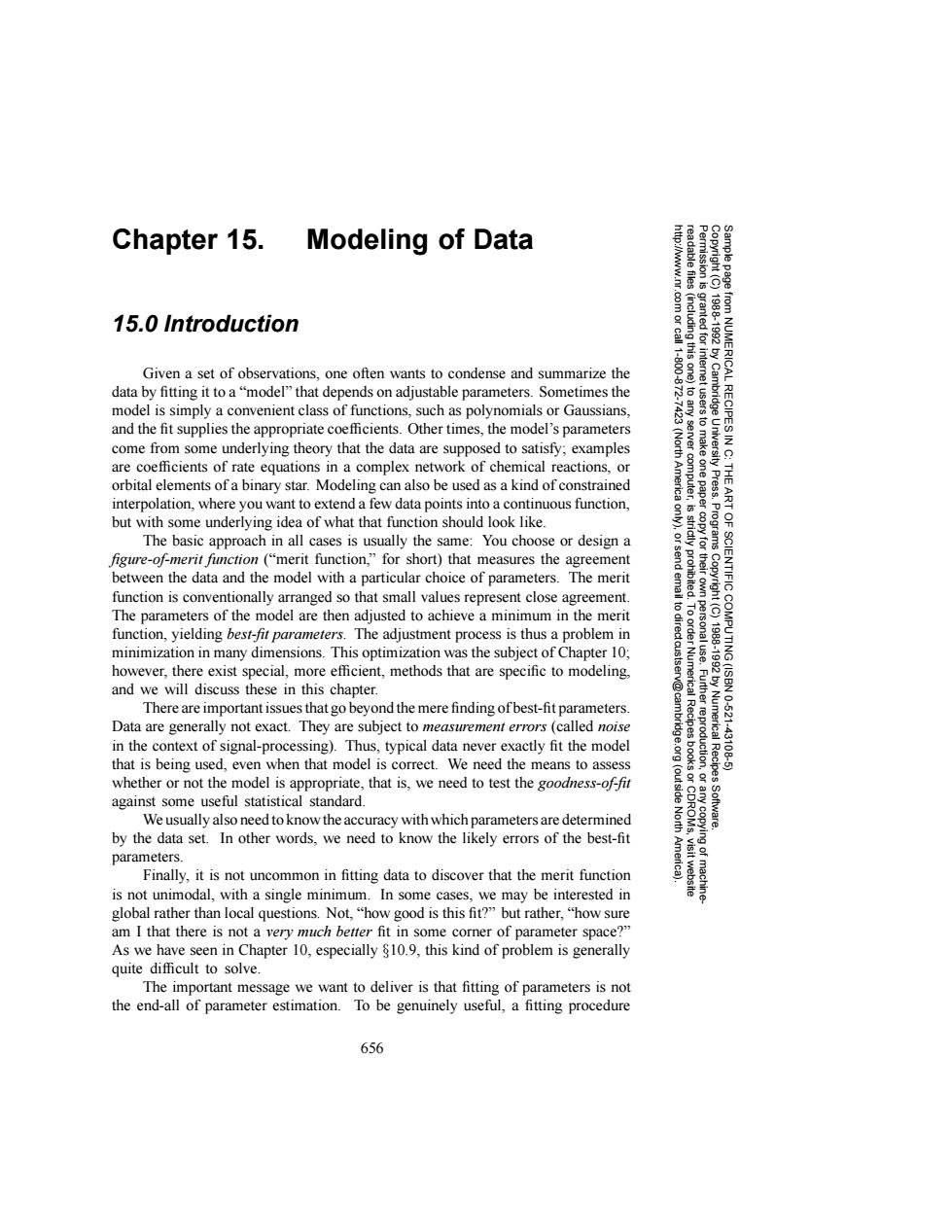正在加载图片...

Chapter 15. Modeling of Data http://www.nr. 15.0 Introduction or call Given a set of observations,one often wants to condense and summarize the data by fitting it to a"model"that depends on adjustable parameters.Sometimes the 茶关 Cambridge model is simply a convenient class of functions,such as polynomials or Gaussians, NUMERICAL RECIPES IN and the fit supplies the appropriate coefficients.Other times,the model's parameters come from some underlying theory that the data are supposed to satisfy;examples are coefficients of rate equations in a complex network of chemical reactions,or 2 compu orbital elements of a binary star.Modeling can also be used as a kind of constrained Press. C:THEA interpolation,where you want to extend a few data points into a continuous function, but with some underlying idea of what that function should look like. The basic approach in all cases is usually the same:You choose or design a 马 figure-of-merit fumnction("merit function,"for short)that measures the agreement between the data and the model with a particular choice of parameters.The merit SCIENTIFIC function is conventionally arranged so that small values represent close agreement. The parameters of the model are then adjusted to achieve a minimum in the merit function,yielding best-fit parameters.The adjustment process is thus a problem in minimization in many dimensions.This optimization was the subject of Chapter 10: however,there exist special,more efficient,methods that are specific to modeling, 6 r Numer and we will discuss these in this chapter. rical There are important issues that go beyond the mere finding ofbest-fit parameters. Data are generally not exact.They are subject to measurement errors(called noise in the context of signal-processing).Thus,typical data never exactly fit the model that is being used,even when that model is correct.We need the means to assess ecipes whether or not the model is appropriate,that is,we need to test the goodness-offir against some useful statistical standard. We usually also need to know the accuracy with which parameters are determined Software. by the data set.In other words,we need to know the likely errors of the best-fit parameters. Finally,it is not uncommon in fitting data to discover that the merit function America) visit website is not unimodal,with a single minimum.In some cases,we may be interested in machine global rather than local questions.Not,"how good is this fit?"but rather,"how sure am I that there is not a very much better fit in some corner of parameter space?" As we have seen in Chapter 10.especially 810.9.this kind of problem is generally quite difficult to solve. The important message we want to deliver is that fitting of parameters is not the end-all of parameter estimation.To be genuinely useful,a fitting procedure 656Permission is granted for internet users to make one paper copy for their own personal use. Further reproduction, or any copyin Copyright (C) 1988-1992 by Cambridge University Press. Programs Copyright (C) 1988-1992 by Numerical Recipes Software. Sample page from NUMERICAL RECIPES IN C: THE ART OF SCIENTIFIC COMPUTING (ISBN 0-521-43108-5) g of machinereadable files (including this one) to any server computer, is strictly prohibited. To order Numerical Recipes books or CDROMs, visit website http://www.nr.com or call 1-800-872-7423 (North America only), or send email to directcustserv@cambridge.org (outside North America). Chapter 15. Modeling of Data 15.0 Introduction Given a set of observations, one often wants to condense and summarize the data by fitting it to a “model” that depends on adjustable parameters. Sometimes the model is simply a convenient class of functions, such as polynomials or Gaussians, and the fit supplies the appropriate coefficients. Other times, the model’s parameters come from some underlying theory that the data are supposed to satisfy; examples are coefficients of rate equations in a complex network of chemical reactions, or orbital elements of a binary star. Modeling can also be used as a kind of constrained interpolation, where you want to extend a few data points into a continuous function, but with some underlying idea of what that function should look like. The basic approach in all cases is usually the same: You choose or design a figure-of-merit function (“merit function,” for short) that measures the agreement between the data and the model with a particular choice of parameters. The merit function is conventionally arranged so that small values represent close agreement. The parameters of the model are then adjusted to achieve a minimum in the merit function, yielding best-fit parameters. The adjustment process is thus a problem in minimization in many dimensions. This optimization was the subject of Chapter 10; however, there exist special, more efficient, methods that are specific to modeling, and we will discuss these in this chapter. There are important issues that go beyond the mere finding of best-fit parameters. Data are generally not exact. They are subject to measurement errors (called noise in the context of signal-processing). Thus, typical data never exactly fit the model that is being used, even when that model is correct. We need the means to assess whether or not the model is appropriate, that is, we need to test the goodness-of-fit against some useful statistical standard. We usually also need to know the accuracy with which parameters are determined by the data set. In other words, we need to know the likely errors of the best-fit parameters. Finally, it is not uncommon in fitting data to discover that the merit function is not unimodal, with a single minimum. In some cases, we may be interested in global rather than local questions. Not, “how good is this fit?” but rather, “how sure am I that there is not a very much better fit in some corner of parameter space?” As we have seen in Chapter 10, especially §10.9, this kind of problem is generally quite difficult to solve. The important message we want to deliver is that fitting of parameters is not the end-all of parameter estimation. To be genuinely useful, a fitting procedure 656